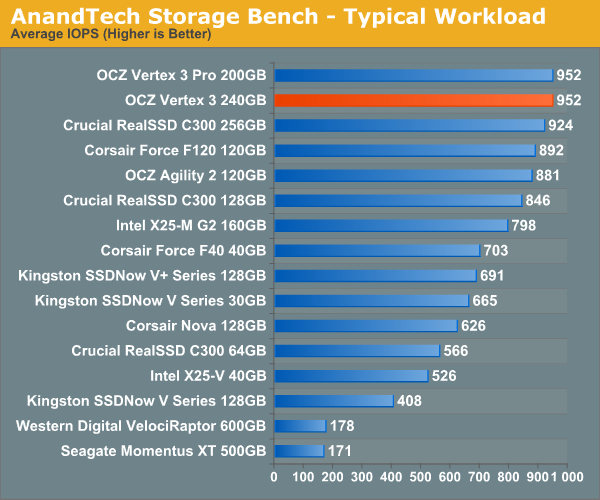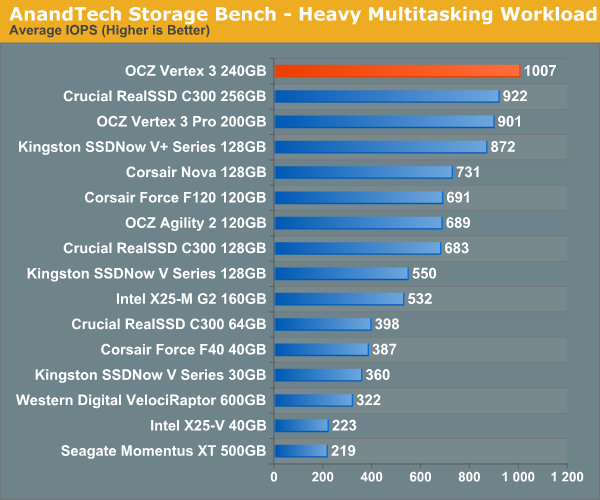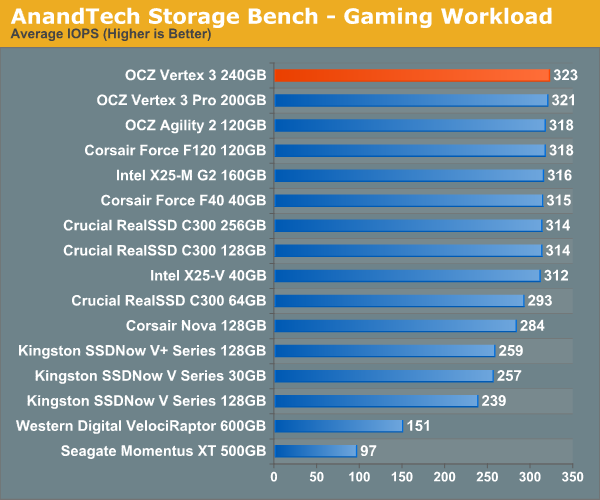OCZ Vertex 3 Preview: Faster and Cheaper than the Vertex 3 Pro
by Anand Lal Shimpi on February 24, 2011 9:02 AM ESTAnandTech Storage Bench 2010
To keep things consistent we've also included our older Storage Bench. Note that the old storage test system doesn't have a SATA 6Gbps controller, so we only have one result for the 6Gbps drives.
The first in our benchmark suite is a light/typical usage case. The Windows 7 system is loaded with Firefox, Office 2007 and Adobe Reader among other applications. With Firefox we browse web pages like Facebook, AnandTech, Digg and other sites. Outlook is also running and we use it to check emails, create and send a message with a PDF attachment. Adobe Reader is used to view some PDFs. Excel 2007 is used to create a spreadsheet, graphs and save the document. The same goes for Word 2007. We open and step through a presentation in PowerPoint 2007 received as an email attachment before saving it to the desktop. Finally we watch a bit of a Firefly episode in Windows Media Player 11.
There’s some level of multitasking going on here but it’s not unreasonable by any means. Generally the application tasks proceed linearly, with the exception of things like web browsing which may happen in between one of the other tasks.
The recording is played back on all of our drives here today. Remember that we’re isolating disk performance, all we’re doing is playing back every single disk access that happened in that ~5 minute period of usage. The light workload is composed of 37,501 reads and 20,268 writes. Over 30% of the IOs are 4KB, 11% are 16KB, 22% are 32KB and approximately 13% are 64KB in size. Less than 30% of the operations are absolutely sequential in nature. Average queue depth is 6.09 IOs.
The performance results are reported in average I/O Operations per Second (IOPS):

If there’s a light usage case there’s bound to be a heavy one. In this test we have Microsoft Security Essentials running in the background with real time virus scanning enabled. We also perform a quick scan in the middle of the test. Firefox, Outlook, Excel, Word and Powerpoint are all used the same as they were in the light test. We add Photoshop CS4 to the mix, opening a bunch of 12MP images, editing them, then saving them as highly compressed JPGs for web publishing. Windows 7’s picture viewer is used to view a bunch of pictures on the hard drive. We use 7-zip to create and extract .7z archives. Downloading is also prominently featured in our heavy test; we download large files from the Internet during portions of the benchmark, as well as use uTorrent to grab a couple of torrents. Some of the applications in use are installed during the benchmark, Windows updates are also installed. Towards the end of the test we launch World of Warcraft, play for a few minutes, then delete the folder. This test also takes into account all of the disk accesses that happen while the OS is booting.
The benchmark is 22 minutes long and it consists of 128,895 read operations and 72,411 write operations. Roughly 44% of all IOs were sequential. Approximately 30% of all accesses were 4KB in size, 12% were 16KB in size, 14% were 32KB and 20% were 64KB. Average queue depth was 3.59.

The gaming workload is made up of 75,206 read operations and only 4,592 write operations. Only 20% of the accesses are 4KB in size, nearly 40% are 64KB and 20% are 32KB. A whopping 69% of the IOs are sequential, meaning this is predominantly a sequential read benchmark. The average queue depth is 7.76 IOs.











85 Comments
View All Comments
ErikO - Wednesday, March 9, 2011 - link
It has been over two years, since I took the plunge for SSD, and on my third one, (Intel SLC), I'm loving it, as McDonalds marketing team would surely love everyone to say.I started with that woeful OCZ SSD, (that created more noise than the Mohammad Cartoons in the world).
They sent me a second one by some way of peace offering (I wrote them from the address of a small tech site I own), but public reviews said they were just as bad. Sold on Ebay with no reserve. (almost got my money back too)
Then a year ago, my wallet allowed for a 160GB X25-M. That was -worlds- better, but still every now and then (once an hour?) my music would skip - and I recognised that as MLC behaviour. This would be the high-latency small-file-size writes then. But as an audiophile, who does actually connect his computer to his hi-fi (via a dedicated sound card of course), this meant noticable breaks in a high output system. Not cool in front of guests.
So a couple of weeks back, I bought the 64GB X25-E. This was everything I had hoped for. This is what I expected SSDs would give us from day one. The size of the disk is painful though, but I digress.
My question is...with all these much higher results out there, am I really going to perceive much of a difference in system-wide performance? Intel seems to be dropping SLC as far as I can see, and based on my experience, I don't think I can / could turn my back on SLC technology again...!
So where is all the talk of the X25-E - of recent? They are for sale everywhere, but the internet seems almost dead to their existance. Too small? Too expensive?
Even if I can be convinced into a Vertex, I will definately have to pay the high admission cost for the pro...I'd happily sacrifice some speed for consistancy of performance.
Gents, let me know what you know?
Thanks.
SeattleGeek - Thursday, March 10, 2011 - link
Will the 128GB model perform the same as the 256GB model that is reviewed?Also, do they have the same number of channels?
sean.crees - Friday, March 11, 2011 - link
Where are the benchmarks for the Vertex 2? I'd really like to see how exactly the new Vertex 3 compares to the drive it's supposed to replace.Dssguy1 - Monday, April 18, 2011 - link
Because we know OCZ is infamous for trickery, I would like to know if you got some kind of "super juiced-up" version of the drive for review.It would make me feel a lot better about dropping $550 (basically because I just did), if I knew that the review SSD you tested, matches what we are getting when we buy the Retail version.
davele - Friday, December 30, 2011 - link
Based on what you describe I wonder if this testing is really a representative snapshot of any common use pattern.ie: Application installs - typically this is a once off activity. Any one machine only installs a finite number of applications. (the exception being a SCOM based virtual desktop where the entire systems is installed each time a user logs on. But that is Enterprise & they are very unlikely to put SSD's in user workstations)
For Enterprise SSD benchmarks please consider profiling a SQL Server system running both normal OLTP app & a Sharepoint app.
The OLTP would give you huge numbers of 4K & 64K random writes, while the logs would give you largely a sequential write. The Sharepoint app is a heavy BLOB store, So this would give you the a random set of large sequential I/O, with much more Read than Write.
The advantage of this is you can backup the database, capture the I/O requests. Then each test is just a restore & replay of the requests. Easy, repeatable & extremely representative of Heavy I/O workload. Especially an enterprise class load.